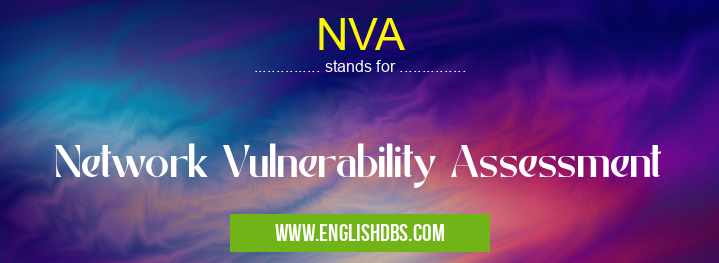What does NVA mean in NETWORKING
Network Vulnerability Assessment (NVA) is a powerful tool used to identify potential security risks in computer networks. It can help organizations take corrective actions and prevent potential attacks on their IT infrastructure. NVA is a detailed, comprehensive process that helps identify weaknesses and threats in a network environment. By performing an NVA, organizations can detect any existing vulnerabilities and provide remediation steps for non-compliance issues.

NVA meaning in Networking in Computing
NVA mostly used in an acronym Networking in Category Computing that means Network Vulnerability Assessment
Shorthand: NVA,
Full Form: Network Vulnerability Assessment
For more information of "Network Vulnerability Assessment", see the section below.
» Computing » Networking
Benefits Of Network Vulnerability Assessments
Using an NVA allows organizations to discover potential vulnerabilities before attackers do. By patching these vulnerabilities in advance it keeps them safe from malicious actors looking to exploit loopholes in their network defenses. Additionally, it highlights any misconfigurations or weak spots in their IT infrastructure giving them the opportunity to address these issues before they can become exploited by attackers. Regular assessments provide organizations with visibility into their networks so they can quickly mitigate any threats while also providing early warnings when new or unknown ones are detected. These proactive measures allow organisations to remain ahead of criminals who are looking for weaknesses in their defences. Ultimately, allowing them to better protect their assets against cyber terror tactics such as ransomware or data breaches which can have crippling effects not only financially but on brand reputations too.
Essential Questions and Answers on Network Vulnerability Assessment in "COMPUTING»NETWORKING"
What is a Network Vulnerability Assessment (NVA)?
Network Vulnerability Assessments are a comprehensive security review of an organization's network infrastructure. This includes both external and internal systems, as well as devices, applications, and other related components. This process ensures that the appropriate measures have been taken to secure the network from potential threats.
What types of security risks does an NVA help identify?
An NVA helps identify various types of cyber-security threats such as malware, unauthorized access points, malicious code injections, system misconfigurations, weak passwords, or unprotected shared resources.
How often should I conduct an NVA?
It is recommended to perform an NVA at least once every quarter to ensure your organization’s security posture remains up to date.
Are there any common challenges faced during an NVA?
Yes - some challenges faced during NVAs include obtaining adequate visibility into the network environment, determining which vulnerabilities are most crucial to mitigate first, working with limited resources and budget constraints, analyzing large amounts of data in a timely manner, mitigating false positives or false negatives.
What actions do I need to take after conducting an NVA?
After conducting an NVA it is important to prioritize mitigation efforts based on severity levels for identified vulnerabilities. Remediation steps should also be developed based on mitigations and audits conducted. Additionally you can deploy automated patch management solutions if applicable and use penetration testing tools for further assurance.
Is there anything else I should consider when performing an NVA?
Absolutely - it is important to remain vigilant by regularly monitoring the environment for any changes or new threats that may arise over time. Additionally you should always document your findings and remediation actions so that they can easily be referred back to in the future if needed.
Does my organization need specialized expertise for performing Network Vulnerability Assessments?
In short - likely yes. Depending on the size and complexity of your network you may require expertise in fields such as Information Security Auditing & Compliance Regulations or Penetration Testing & Vulnerability Analysis. Having someone on board who has experience with these fields could potentially save time and help reduce risk more efficiently.
How long will it take me to complete an NVA?
The length of time required to complete a Network Vulnerability Assessment will depend largely on the size of your network environment - larger networks with many different assets may take longer than smaller ones with fewer assets. On average though you can generally expect it to take at least several days.
Final Words:
NVA is vital for keeping digital assets secure; it is essentially acting as a pre-emptive measure against malicious activity on networks by exposing latent flaws before they can become exploited by hackers or criminals alike. Companies must make sure that regular vulnerability assessments are conducted which include both internal scans of the network as well as external scans from outside sources such as third party providers who offer penetration tests among other services like bug bounty programmes.. By doing so organizations have more confidence when it comes to protecting user data privacy and preventing data breaches from occurring This could be essential for compliance with regulatory bodies such as GDPR if companies are storing confidential customer data.
NVA also stands for: |
|
| All stands for NVA |
